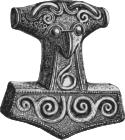- Óðrerir
-
In Norse mythology, Óðrerir, Óðrørir or Óðrœrir refers either to one of the vessels that contain the mead of poetry (along with Boðn and Són) or to the mead itself.
Contents
Attestations
Poetic Edda
Óðrerir is mentioned in two ambiguous passages of the Hávamál. In a first stanza (107), it is sometimes assumed that Óðrerir is synonymous with mead of poetry[1], but both interpretations are possible.
- Of a well-assumed form
- I made good use:
- few things fail the wise;
- for Odhrærir
- is now come up
- to men’s earthly dwellings
-
- —Hávamál (108), Thorpe's translation
In another stanza (140), the meaning of Óðrerir depends on the translation.
- Fimbulljóð níu
- nam ek af inum frægja syni
- Bölþorns, Bestlu föður,
- ok ek drykk of gat
- ins dýra mjaðar,
- ausinn Óðreri.
- —Hávamál (140), Guðni Jónsson's edition
- Potent songs nine
- from the famed son I learned
- of Bölthorn, Bestla’s sire,
- and a draught obtained
- of the precious mead,
- drawn from Odhrærir.
-
- —Hávamál (142), Thorpe's translation
In most translations, Óðrerir seems to refer to a vessel, but other interpretations of ausinn Óðreri are possible[2], which can lead to understand Óðrerir to be the mead itself.
Prose Edda
For Snorri Sturluson, Óðrerir is the name of the kettle in which Kvasir's blood was mixed with honey to create the mead:
- [Kvasir] went up and down the earth to give instruction to men; and when he came upon invitation to the abode of certain dwarves, Fjalar and Galarr, they called him into privy converse with them, and killed him, letting his blood run into two vats and a kettle. The kettle is named Ódrerir, and the vats Són and Bodn; they blended honey with the blood, and the outcome was that mead by the virtue of which he who drinks becomes a skald or scholar.
Similarly, Snorri considers that "liquid of Óðrerir and Boðn and Són" (lögr Óðreris ok Boðnar ok Sónar) is a kenning for the mead of poetry (Skáldskaparmál, 3).
But in skaldic poetry, Óðrerir is a synonym of mead of poetry[1] and it is therefore assumed that Óðrerir as a vessel is Snorri's invention. Moreover, the etymology of the name – which can be rendered into "stirrer of inspiration" or "stirrer of fury" – suggests that it rather refers to the mead. Boðn probably means "vessel"[1] and Són signifies either "reconciliation"[3] or "blood"[4]. Alternatively, if Boðn and Són are related to the Danish words "Bod" and "Soning", Boðn could mean something like "penance" and Són "repentance".
Notes
References
- Brodeur, Arthur Gilchrist (trans.). 1916. Snorri Sturluson: The Prose Edda. New York: The American-Scandinavian Foundation.
- Faulkes, Anthony (ed.). 1998. Snorri Sturluson: Edda. Skáldskaparmál. Vol. 2, Glossary and Index of Names. London: Viking Society for Northern Research. ISBN 0-903521-38-5.
- Guðni Jónsson (ed.). 1949. Eddukvæði: Sæmundar-Edda. Reykjavík: Íslendingasagnaútgáfan.
- Lindow, John. 2002. Norse Mythology: A Guide to the Gods, Heroes, Rituals, and Beliefs. New York: Oxford University Press. First published in 2001 by ABC-Clio. ISBN 0-19-515382-0.
- Simek, Rudolf. 1996. Dictionary of Northern Mythology. Translated by Angela Hall. First published by Alfred Kröner Verlang in 1984. Cambridge: D. S. Brewer. ISBN 0-85991-513-1.
- Thorpe, Benjamin (trans.). 1866. Edda Sæmundar Hinns Froða: The Edda Of Sæmund The Learned. London: Trübner & Co.
Norse paganism Deities,
heroes,
and figuresOthersAsk and Embla · Dís (Norns · Valkyries) · Dwarf · Einherjar · Elves (Light elves · Dark elves) · Fenrir · Hel · Jörmungandr · Jötunn · Sigurd · Völundr · Vættir
Locations Asgard · Bifröst · Fólkvangr · Ginnungagap · Hel · Jötunheimr · Midgard · Múspellsheimr · Niflheim · Valhalla · Vígríðr · Wells (Mímisbrunnr · Hvergelmir · Urðarbrunnr) · YggdrasilEvents Sources Society See also Categories:- Artifacts in Norse mythology
Wikimedia Foundation. 2010.
